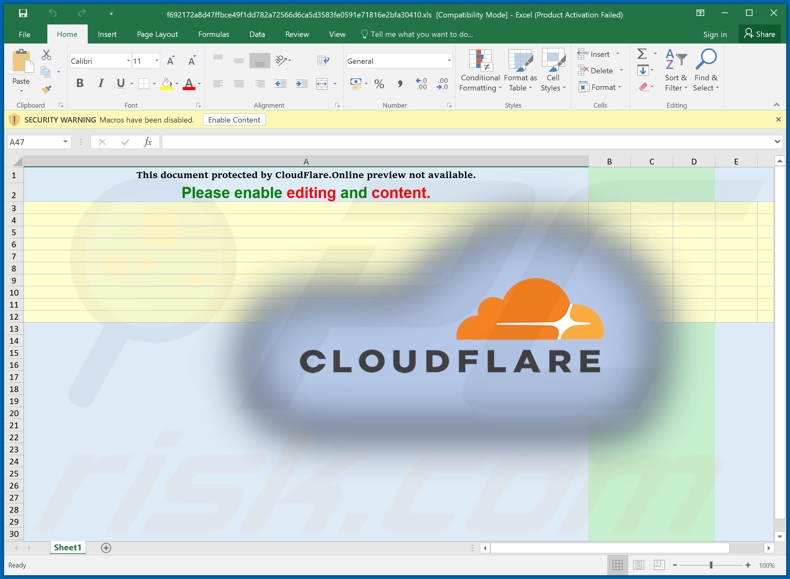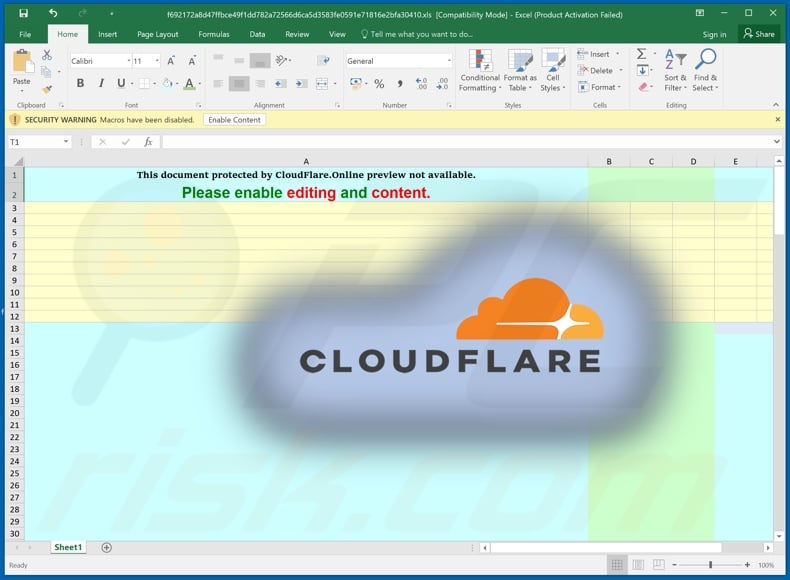Do not open documents claiming "This document protected by CloudFlare"
TrojanAlso Known As: "This document protected by CloudFlare" virus
Get free scan and check if your device is infected.
Remove it nowTo use full-featured product, you have to purchase a license for Combo Cleaner. Seven days free trial available. Combo Cleaner is owned and operated by RCS LT, the parent company of PCRisk.com.
What is the "This document protected by CloudFlare" scam?
"This document protected by CloudFlare" is a deceptive message displayed by various malicious documents. Cloudflare is a legitimate web-infrastructure and website-security company, which is in no way associated with this scam message.
"This document protected by CloudFlare" attempts to convince users that the infectious Microsoft Office document is locked and they need to enable macro commands (i.e. enable editing/content) to access it. Note that these documents are dangerous, since their purpose is to infect systems with malware. Malicious files are commonly distributed via spam email campaigns.

As well as stating that the document is allegedly protected by "CloudFlare", this scam might also claim that an online preview of the file is unavailable. Typically, users are urged to enable editing and/or content. Additionally, the malicious documents can have the actual logo of CloudFlare emblazoned on them.
Such files are used to proliferate a wide variety of malware such as Trojans, ransomware, cryptominers, etc. When users allow editing/content on Microsoft Office documents, they enable macro commands. Virulent documents infect systems by executing malicious macros, which initiates the infection process/chain (i.e. download/installation of malware).
In Microsoft Office versions released before 2010, macro commands are executed when a document is opened. In later versions, the infection processes can only begin after macros (i.e. editing/content) are manually enabled. Various malicious programs can infiltrate systems in this manner and they can have a broad range of dangerous functionalities.
Malware can be multi-functional with varied capabilities in different versions. Examples are:
Remote Access Trojans (RATs), which allow remote access and control over infected machines (e.g. Ratty, VanTom, etc.);
loader/backdoor Trojans, which cause chain infections and inject systems with additional malware (e.g. sLoad, Legion, etc.);
information stealers, which target a variety of data by using different techniques (e.g. Echelon, GraceWire, etc.); banking malware, which targets banking information specifically (e.g. Mekotio, Zeus Sphinx, etc.);
keyloggers, which record key strokes (e.g. 404, Hakops, etc.); ransomware, which encrypts data and demands ransoms for decryption (e.g. Jwjs, VinDizelPux, etc.);
screenlockers, which lock device screens for payment (e.g. ComputerDestroyer, Rubly, etc.); cryptominers, which generate cryptocurrency by using the infected machine's resources (e.g. BitCoinMiner, JSMiner-C, etc.), and so on.
To summarize, malware infections can damage devices, cause data and financial loss, severe privacy issues and lead to identity theft. Therefore, never open suspicious documents claiming that they are protected by "CloudFlare". If it is suspected/known that malware has already infected the system, use anti-virus software to eliminate it immediately.
| Name | "This document protected by CloudFlare" virus |
| Threat Type | Trojan, password-stealing virus, banking malware, spyware. |
| Detection Names | Symantec (Scr.MalMacro!gen2), Dr.Web vxCube (EXPLOIT), Full List (VirusTotal). |
| Symptoms | Trojans are designed to stealthily infiltrate the victim's computer and remain silent, and thus no particular symptoms are clearly visible on an infected machine. |
| Distribution methods | Infected email attachments, malicious online advertisements, social engineering, software 'cracks'. |
| Damage | Stolen passwords and banking information, identity theft, the victim's computer added to a botnet. |
| Malware Removal (Windows) |
To eliminate possible malware infections, scan your computer with legitimate antivirus software. Our security researchers recommend using Combo Cleaner. Download Combo CleanerTo use full-featured product, you have to purchase a license for Combo Cleaner. 7 days free trial available. Combo Cleaner is owned and operated by RCS LT, the parent company of PCRisk.com. |
Malicious files are typically sent by the thousand, during large scale operations called "spam campaigns". Infectious files can be Microsoft Office and PDF documents, archive and executable files, JavaScript, etc. When the files are executed, run or otherwise opened, the infection process is triggered.
The emails distributed via spam campaigns are usually presented as "official", "urgent", "priority", "important" and similar. They might even be disguised as mail from legitimate institutions organizations, companies, etc.
"Inland Revenue Exchange System", "Covid-19 Health and Safety Plan", and "Request for quotation" are some examples of malware-spreading spam campaigns, however, deceptive emails are also used for phishing and other scams.
How did "This document protected by CloudFlare Scam" infiltrate my computer?
As well as spam campaigns, which were described in the previous paragraph, malware is proliferated through untrusted download channels, illegal activation tools ("cracks") and fake updaters.
Dubious download sources such as unofficial and free file-hosting websites, Peer-to-Peer sharing networks (BitTorrent, eMule, Gnutella, etc.) and other third party downloaders can offer malicious programs for downloading, disguised as or bundled with normal content.
"Cracking" tools can download/install malware rather than activating licensed products. Rogue updaters infect systems by exploiting weaknesses of outdated products and/or simply by installing malicious software, rather than the promised updates.
How to avoid installation of malware
Do not open suspect or irrelevant emails, especially those with any attachments or links present, as this can lead to high-risk infection. Additionally, use only Microsoft Office versions released after 2010. All downloads must be done from official and verified sources.
It is also important to activate and update products with tools/functions provided by legitimate developers. To ensure device and user safety, it is crucial to have a reputable anti-virus/anti-spyware suite installed. This software must be kept up to date, used to run regular system scans and to remove detected/potential threats.
If you believe that your computer is already infected, we recommend running a scan with Combo Cleaner Antivirus for Windows to automatically eliminate infiltrated malware.
Screenshot of a malicious document with the "This document protected by CloudFlare" deceptive message, distributing the TrickBot Trojan:

Instant automatic malware removal:
Manual threat removal might be a lengthy and complicated process that requires advanced IT skills. Combo Cleaner is a professional automatic malware removal tool that is recommended to get rid of malware. Download it by clicking the button below:
DOWNLOAD Combo CleanerBy downloading any software listed on this website you agree to our Privacy Policy and Terms of Use. To use full-featured product, you have to purchase a license for Combo Cleaner. 7 days free trial available. Combo Cleaner is owned and operated by RCS LT, the parent company of PCRisk.com.
Quick menu:
- What is This document protected by CloudFlare Scam?
- STEP 1. Manual removal of possible malware infections.
- STEP 2. Check if your computer is clean.
How to remove malware manually?
Manual malware removal is a complicated task - usually it is best to allow antivirus or anti-malware programs to do this automatically. To remove this malware we recommend using Combo Cleaner Antivirus for Windows.
If you wish to remove malware manually, the first step is to identify the name of the malware that you are trying to remove. Here is an example of a suspicious program running on a user's computer:

If you checked the list of programs running on your computer, for example, using task manager, and identified a program that looks suspicious, you should continue with these steps:
 Download a program called Autoruns. This program shows auto-start applications, Registry, and file system locations:
Download a program called Autoruns. This program shows auto-start applications, Registry, and file system locations:

 Restart your computer into Safe Mode:
Restart your computer into Safe Mode:
Windows XP and Windows 7 users: Start your computer in Safe Mode. Click Start, click Shut Down, click Restart, click OK. During your computer start process, press the F8 key on your keyboard multiple times until you see the Windows Advanced Option menu, and then select Safe Mode with Networking from the list.

Video showing how to start Windows 7 in "Safe Mode with Networking":
Windows 8 users: Start Windows 8 is Safe Mode with Networking - Go to Windows 8 Start Screen, type Advanced, in the search results select Settings. Click Advanced startup options, in the opened "General PC Settings" window, select Advanced startup.
Click the "Restart now" button. Your computer will now restart into the "Advanced Startup options menu". Click the "Troubleshoot" button, and then click the "Advanced options" button. In the advanced option screen, click "Startup settings".
Click the "Restart" button. Your PC will restart into the Startup Settings screen. Press F5 to boot in Safe Mode with Networking.

Video showing how to start Windows 8 in "Safe Mode with Networking":
Windows 10 users: Click the Windows logo and select the Power icon. In the opened menu click "Restart" while holding "Shift" button on your keyboard. In the "choose an option" window click on the "Troubleshoot", next select "Advanced options".
In the advanced options menu select "Startup Settings" and click on the "Restart" button. In the following window you should click the "F5" button on your keyboard. This will restart your operating system in safe mode with networking.

Video showing how to start Windows 10 in "Safe Mode with Networking":
 Extract the downloaded archive and run the Autoruns.exe file.
Extract the downloaded archive and run the Autoruns.exe file.

 In the Autoruns application, click "Options" at the top and uncheck "Hide Empty Locations" and "Hide Windows Entries" options. After this procedure, click the "Refresh" icon.
In the Autoruns application, click "Options" at the top and uncheck "Hide Empty Locations" and "Hide Windows Entries" options. After this procedure, click the "Refresh" icon.

 Check the list provided by the Autoruns application and locate the malware file that you want to eliminate.
Check the list provided by the Autoruns application and locate the malware file that you want to eliminate.
You should write down its full path and name. Note that some malware hides process names under legitimate Windows process names. At this stage, it is very important to avoid removing system files. After you locate the suspicious program you wish to remove, right click your mouse over its name and choose "Delete".

After removing the malware through the Autoruns application (this ensures that the malware will not run automatically on the next system startup), you should search for the malware name on your computer. Be sure to enable hidden files and folders before proceeding. If you find the filename of the malware, be sure to remove it.

Reboot your computer in normal mode. Following these steps should remove any malware from your computer. Note that manual threat removal requires advanced computer skills. If you do not have these skills, leave malware removal to antivirus and anti-malware programs.
These steps might not work with advanced malware infections. As always it is best to prevent infection than try to remove malware later. To keep your computer safe, install the latest operating system updates and use antivirus software. To be sure your computer is free of malware infections, we recommend scanning it with Combo Cleaner Antivirus for Windows.
Share:

Tomas Meskauskas
Expert security researcher, professional malware analyst
I am passionate about computer security and technology. I have an experience of over 10 years working in various companies related to computer technical issue solving and Internet security. I have been working as an author and editor for pcrisk.com since 2010. Follow me on Twitter and LinkedIn to stay informed about the latest online security threats.
PCrisk security portal is brought by a company RCS LT.
Joined forces of security researchers help educate computer users about the latest online security threats. More information about the company RCS LT.
Our malware removal guides are free. However, if you want to support us you can send us a donation.
DonatePCrisk security portal is brought by a company RCS LT.
Joined forces of security researchers help educate computer users about the latest online security threats. More information about the company RCS LT.
Our malware removal guides are free. However, if you want to support us you can send us a donation.
Donate
▼ Show Discussion